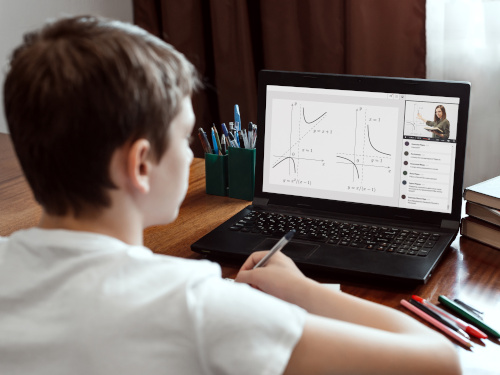While the pandemic accelerated the demand for virtual learning, it’s clear that online pedagogy is now an integral part of an educator’s toolbox. As part of this shift to hybrid or virtual learning models, today’s educators face a new set of demands – it’s not just about teaching the curriculum; it’s about understanding and leveraging the tools that make learning possible and beneficial.
As many of our interactions move online or become increasingly integrated with the digital world, teachers and the universities that prepare them need to shift as well.
Expanding Possibilities with In-Person and Virtual Learning
I spent 10 years working in classrooms as a substitute teacher, but I decided to advance my career by becoming a certified middle school math teacher. I student-taught for two semesters through a program at Lewis University in partnership with Proximity Learning, a company that makes it possible for certified teachers to live stream into classrooms around the country. When structuring my education, I felt that teaching one semester in-person and one virtually would best prepare me for an unpredictable educational field.
I selected this program because it provides student teachers with the coaching and experience to thrive in any educational setting. In order for me to feel prepared to teach in both in-person and online classrooms, I wanted the mentorship, tech skills, and learning strategies to build my confidence in connecting and engaging with students.
Many teachers can attest that the energy of the classroom inspires them on their toughest days. There’s nothing quite like the spirit and collaboration of in-person teaching. I was a little hesitant to teach online, worried that virtual teaching would dull that spark.
However, after collaborating with my mentor teachers and learning how to use technology to engage with students, I was amazed at the possibilities.
Fostering Cross-Country Classroom Collaboration
Guided by my Proximity Learning mentor teacher, Elizabeth Dodds, I dove into new tech tools and remote learning strategies.
I tackled platforms like Nearpod, Google Classroom, and Kahoot, learning how to use them to encourage meaningful conversations and learning opportunities that mirrored what I experienced in a brick-and-mortar classroom. Elizabeth showed me how to cultivate confidence and comfort for both students and teachers in the virtual classroom. Through her expertise in lesson planning and technology, I learned how to implement remote learning strategies into my instructional practices.
During my remote teaching semester, students from South Carolina and other parts of Illinois learned alongside each other virtually as I taught from Plainfield, Illinois. Interactions between students across multiple states infused our discussions with new perspectives, experiences, and questions.
While each child’s learning needs differ, all my students flourished in this live synchronous model. Giving students the chance to try out remote learning technology doesn’t just offer a short-term educational experience; it prepares them for a world where technology is integrated into our everyday lives.
Launching a Teaching Career in a Tumultuous Time
Although I already had classroom experience as a substitute, a full-time teaching career requires different skills, knowledge, and grit. It won’t surprise anyone to say today’s teaching environment is in turmoil, with over 55 percent of respondents to an Education Association survey stating they are more likely to leave the profession or retire early.
Teachers are facing burnout, stress, and the challenge of taking on more work due to staffing shortages. But for many of us, the motivation to positively impact our students and communities keeps us driving forward.
By strengthening my background in both in-person and virtual learning, I know that I can lead a classroom in an environment that demands adaptability, tenacity and a steadfast commitment to providing my students with an optimal educational experience. Research says that high-quality teachers have two to three times the effect of any other school-related factor on student performance on reading and math tests, so we know the value we bring to the students who enter our classrooms, either in-person or online.
Virtual learning tools can enhance the traditional classroom experience, as technology has allowed teachers to utilize a flipped classroom. Instead of teaching students how to do something during class and then expecting them to practice at home, technology provides students with access to direct instruction at home and at their own pace. This approach frees up the time spent in the classroom that can be better utilized in the engagement of students in learning experiences.
Embracing the Future of Education
Virtual learning isn’t simply a passing byproduct of the pandemic – it is becoming a necessary element of education. Many districts are implementing long-term virtual learning, and others are using it on an ad-hoc basis. In a recent survey, 39 percent of district leaders have converted snow days to online learning days.
The transition to incorporating more remote and live synchronous instruction demonstrates that online learning can expand the horizons of education. Major opportunities lay ahead of us, like the chance to improve access to technology and online learning for rural and underserved students, develop tools and techniques to further enhance virtual learning environments, and support more educators as they grow their confidence in new teaching strategies.
Exploring in-person and remote learning during my student teaching experience gave me the well-rounded skillset necessary to succeed in teaching today. Whether my career path leads me to virtual or in-person learning, I’m grateful for the knowledge and technical expertise to create a purposeful learning environment for the students in my classroom.
- How school leaders can manage and control emotions - May 10, 2024
- A purposeful approach to tech integration - May 9, 2024
- How school leaders can foster a culturally responsive framework - May 9, 2024

